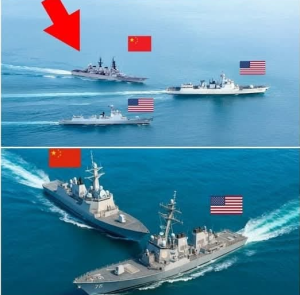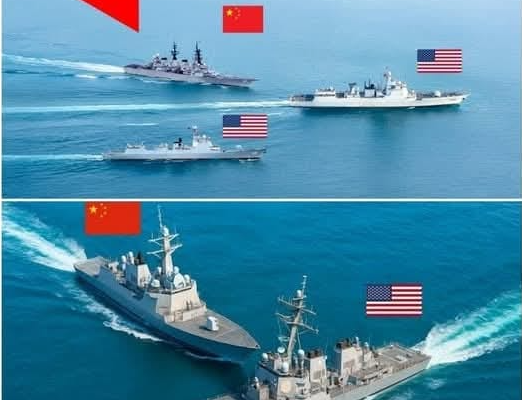
THIS MORNING: U.S. and China Face Off in the South China Sea — A Dangerous Game of Power
Tensions between the world’s two largest military powers — the United States and China — remain high in the South China Sea, one of the world’s most hotly contested waterways. Although no official reports confirm a direct clash today, the situation reflects years of rising friction over territorial claims, freedom of navigation, and regional dominance.
This ongoing standoff highlights how a single incident — even a near miss — could escalate into a global crisis.
A Strategic Crossroads
The South China Sea is a critical maritime zone that connects the Pacific and Indian Oceans. Roughly one-third of global trade passes through this region. The waterway is also rich in natural resources like fisheries, oil, and gas.
China claims nearly the entire sea through the controversial “nine-dash line,” overlapping with the exclusive economic zones of several Southeast Asian countries, including Vietnam, Philippines, Malaysia, and Brunei.
The United States, while not claiming territory, has long insisted on the principle of freedom of navigation, challenging what it views as China’s excessive maritime claims.
Encounters at Sea
Over the past several years, U.S. Navy destroyers and aircraft have routinely conducted freedom-of-navigation operations — sailing close to artificial islands and military outposts built by China. These operations are meant to assert that these are international waters.
China, through the People’s Liberation Army Navy (PLAN) and its coast guard, often responds with radio warnings, shadowing maneuvers, and close intercepts. On multiple occasions, vessels from both sides have come dangerously close.
Defense analysts note that it’s not always about firepower — it’s often about signaling strength and testing resolve.
What a “Brutal Lesson” Could Mean
The phrase “learning a brutal lesson” is often used in military rhetoric or online commentary. In reality, any actual clash between U.S. and Chinese forces would carry massive consequences.
In a hypothetical escalation:
-
U.S. warships could respond rapidly with superior carrier strike group capabilities.
-
China could leverage shore-based anti-ship missile systems and regional naval assets.
-
Cyber and electronic warfare could accompany any kinetic engagement.
-
Regional allies and partners — including Association of Southeast Asian Nations members — would be thrust into crisis diplomacy.
Even a non-lethal collision or misfire could lead to intense diplomatic fallout and military mobilization.
History of Tense Moments
This isn’t the first time such tension has hovered over the region:
-
2001: A U.S. surveillance plane and a Chinese fighter jet collided near Hainan Island, sparking a major diplomatic standoff.
-
2018: A Chinese destroyer came within 45 yards of a U.S. Navy ship during a tense encounter.
-
2023: Multiple close calls were reported between aircraft and ships, leading to warnings from both governments.
These incidents underscore the risks when rival militaries operate in close proximity.
A High-Stakes Chessboard
Military experts say both countries are engaged in a strategic chess match, not a full-blown confrontation. China seeks to solidify its territorial claims and regional influence. The U.S. aims to maintain open sea lanes and support allies like the Philippines.
The stakes are high:
-
Billions of dollars in global trade flow through the region daily.
-
Energy supply routes depend on stability in these waters.
-
Escalation could drag in other nations and potentially trigger a wider conflict.
The Role of Allies and Regional Players
The U.S. isn’t acting alone. Allies and partners play a critical role:
-
The Philippine Navy has increased joint patrols with the U.S. Navy.
-
Japan Maritime Self-Defense Force and Royal Australian Navy have joined multilateral exercises.
-
Smaller Southeast Asian countries, though cautious, watch closely.
For China, asserting dominance over the South China Sea is part of a broader strategy to expand its regional influence and deter foreign interference.
Modern Warfare Beyond the Waves
An actual conflict between the U.S. and China would not be limited to ships and planes. Analysts emphasize that:
-
Cyberattacks could target communication and satellite systems.
-
Electronic warfare could jam navigation and radar.
-
Information warfare — controlling the narrative — would be central.
Both countries have invested heavily in advanced naval capabilities, including aircraft carriers, submarines, and hypersonic missiles.
Diplomatic Pressure Builds
Diplomacy remains the front line of this standoff.
The U.S. maintains that international law — including the 2016 ruling by the Permanent Court of Arbitration, which invalidated China’s sweeping claims — must be respected. China rejects that ruling and continues to fortify its positions on artificial islands.
Every new encounter increases pressure on diplomats to find mechanisms that prevent accidents from turning into war.
A Potential Flashpoint
Security analysts often call the South China Sea a “powder keg” — one miscalculation could ignite a global crisis. Neither Washington nor Beijing appears to want war, but both are determined not to appear weak.
A single collision, missile misfire, or aggressive maneuver could spiral quickly:
-
A tense military standoff,
-
Emergency diplomatic negotiations,
-
Economic and cyber reprisals,
-
And potentially, a wider military mobilization.
This is why many experts stress the importance of clear communication channels, like hotlines between militaries, to defuse incidents in real time.
The Public Narrative and Propaganda
Both nations also engage in public messaging:
-
Chinese state media frames U.S. operations as “provocations.”
-
U.S. officials describe China’s actions as “dangerous and destabilizing.”
-
Social media amplifies both narratives, often with exaggerated claims.
This information battlefield is almost as active as the waters themselves.
The Path Forward
For now, the real battle may not be fought with weapons, but with strategy, diplomacy, and resolve.
Experts suggest several steps to reduce risk:
-
Establish stronger communication channels between militaries.
-
Increase transparency of naval operations.
-
Promote regional agreements on maritime conduct.
-
Use diplomacy to manage competition without conflict.
Conclusion: A Dangerous Dance
No shots were fired this morning — but every close encounter in the South China Sea is a reminder of how fragile peace can be. The U.S. Navy and China’s navy continue their high-stakes dance, shadowing each other through contested waters.
Whether this dance remains a display of strength or turns into something far more dangerous depends on careful choices made by leaders in Washington and Beijing in the days and years to come.
✅ This article is an explanatory news analysis. It does not report an actual military clash but explains the real-world tensions and risks between the U.S. and China in the South China Sea.

